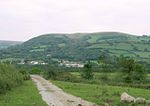Ammanford railway station (GWR)
1840 establishments in Wales1958 disestablishments in WalesDisused railway stations in CarmarthenshireFormer Great Western Railway stationsPages with no open date in Infobox station ... and 4 more
Railway stations in Great Britain closed in 1958Railway stations in Great Britain opened in 1840Use British English from June 2022Wales railway station stubs
Ammanford railway station was opened under the name Cross Inn by the Llanelly Railway in 1840 to serve the town of Ammanford, West Wales. It was renamed Ammanford in 1883. The station was the main one in the town until it closed in 1958, leaving the current Ammanford station (then known as Tirydail, later Ammanford & Tirydail) providing trains for the area.
Excerpt from the Wikipedia article Ammanford railway station (GWR) (License: CC BY-SA 3.0, Authors).Ammanford railway station (GWR)
Park Street,
Geographical coordinates (GPS) Address External links Nearby Places Show on map
Geographical coordinates (GPS)
| Latitude | Longitude |
|---|---|
| N 51.791054 ° | E -3.986149 ° |
Address
Ammanford
Park Street
SA18 3EN , Tir-y-dail
Wales, United Kingdom
Open on Google Maps






